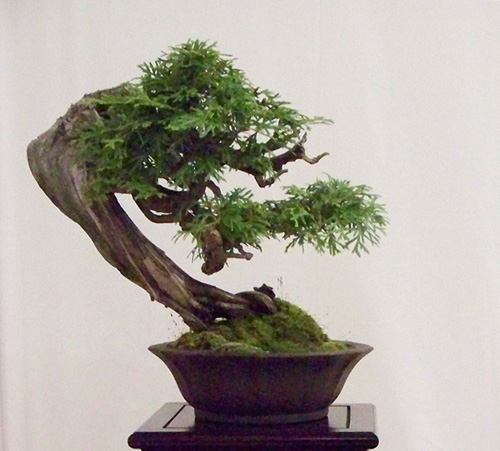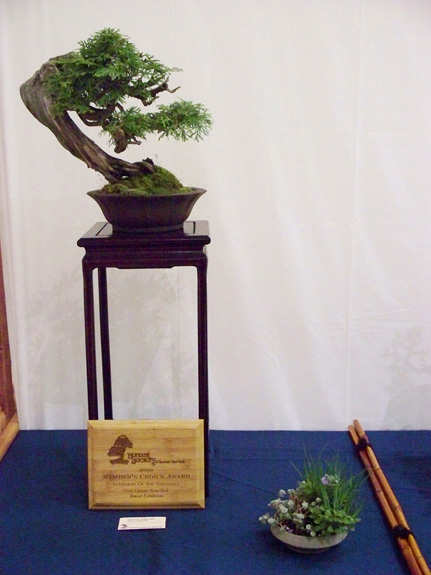
I first saw this Northern white cedar (Thuja occidentalis) in International Bonsai magazine (2009 issue 4). It also appears on the Bonsai Society of Upstate New York’s website. It belongs to Marc Arpag and was part of the Society’s 36th Upstate New York Exhibition (2009). It jumped out at me because I have a thing for cedars, but can never seem to find any that begin to approach this natural wonder.
When is a cedar a cedar (or not)? Common names often create confusion. There are only four true cedar (Cedrus) species in the world, yet an abundance of trees that are commonly called cedars. These include Atlantic white cedar (Cham. thyoides), at least one juniper (Eastern red cedar – J. Virginiana), the Incense cedar (Calocedrus decurrens), the Northern white (also called Eastern white cedar) featured above, the Western red cedar (Thuja plicata) and no doubt several others (anyone else?).
The tree of life All the Thuja genus are arborvitaes (the tree of life), though the tendency seems to be to call the wild species cedars and the domestic cultivars arborvitaes (if you’ve read this far, you are unusual (exceptional?) in the world of bonsai enthusiasts – it always amazes me how few bonsai enthusiasts seem to be interested in trees).

This shot puts the tree a little more into perspective (it looks a little smaller than I originally thought).
Here in the Pacific Northwest we also have Port Orford-cedar (Chamaecyparis lawsoniana) and Yellow-cedar (Callitropsis nootkatensis), the latter of which has been subject to some genus-bending by taxonomists over the years.
Thanks Al. I forgot about the Port Orford cedar. I understand it was almost logged out for its quality wood. I’m not familiar with the Yellow cedar, but intend to look it up right now.
Just checked it out on wikipedia. It seems that it is called a cypress (Cupressus) by some and a false cypress (Chameacyparis) by some, and that’s only half of the story: http://en.wikipedia.org/wiki/Callitropsis_nootkatensis.
Have you tried it for bonsai. How about the Port Orford cedar?
I’ve neither seen nor tried either as bonsai. Orford has extremely limited distribution. I think both have pretty open, lacy fronds that would present a lot of styling challenges.
We of the Toronto Bonsai Society take pride in our T. occidentalis bonsai. They have a reputation as being bad bonsai subjects, but we could not disagree more. We consider them to be the definitive bonsai subject in our area, along with American Larch. Many members have mastered the techniques required to subdue the foliage.
A gallery of just a few of the cedar bonsai of TBS members can be found at:
http://torontobonsai.org/ (click “galleries” at the top then “cedar” at the left)
The tree you posted won the Best Native award at the 2nd National Exhibition in Rochester (as you can see in the second picture). I was very happy to see a T. occidentalis take the prize. It is a great tree, but I am bothered by the dead bark on the front. What may appear to be live vein is not. I understand though, because this old dead bark is incredibly difficult to remove from cedars.
Thanks AK for the TBS info. I checked out your site and plan on featuring some of your trees soon (fully attributed with links of course). Years ago I met someone in Toronto who was collecting cedars from land that belonged to a Native American tribe. Long story short, he stiffed me out of cedar he promised me (he substituted another inferior one when the time came for me to pick it up). Long story short, I later heard (unverified) that he was busted by the tribe. Karma eh?
There is also “cedars” in Southern Africa. Widdringtonia cedarbegensis
Pressed the submit button a bit prematurely and also see that Roger Stones has added the piece about Widdringtonia cedarbergensis. Beautiful trees in the wild but extremely difficult to use for bonsai. It has such strong terminal dominance that I have always ended up with leggy octopuses instead of bonsai!